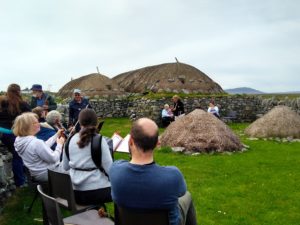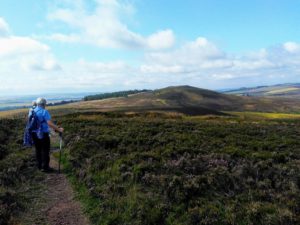Organisations: Historic Environment Scotland (HES) and University of Stirling (UoS)
Type of project and funding: Collaborative Doctoral Award, University of Stirling MATCH Studentship (co-funded by UoS and HES)
Research team: Elizabeth Robson (doctoral student and principal researcher); Siân Jones (Primary Supervisor, UoS); Judith Anderson (Primary Supervisor, HES); Peter Matthews (Co-Supervisor, UoS); Karen Robertson (Co-Supervisor, HES)
This collaborative doctoral project aims to develop a suite of methodologies for the assessment of social and communal values and bring them into the evaluation, management and conservation of the historic environment. It was initially developed by Anderson, Robertson and Jones, who had been discussing how to apply academic research on the social and communal values of heritage in a practical context for some time. A significant barrier to addressing social and communal values in heritage conservation and management is the lack of appropriate methods and associated expertise within heritage organisations. The partnership provided the required mix of academic, professional, and social policy knowledge to develop a robust proposal to address this issue. Once the funding was acquired, Elizabeth Robson was appointed to the doctoral project and further developed the design with the full supervisory team. Project design and implementation was also supported by a Reference Group of HES staff, annual project workshops involving both partners and other sector organisations, and participation by the project team in wider HES/sector initiatives. Robson is based at the University of Stirling, but also spends a significant proportion of time at HES, to gain an understanding of institutional contexts and constraints.
The project has trialled a suite of rapid, qualitative methods for examining social values across seven ‘real-world’ heritage case studies, including sites managed by HES. The case studies involved community members to varying degrees, ranging from participation in researcher-led activities to co-designed approaches. As well as formally established community groups, the project involved informal, self-identifying communities of attachment and practice, including groups not previously engaged in institutional heritage processes. The understandings gained from the case studies will be translated into a methodological ‘toolkit’, providing guidance and resources for heritage professionals conducting values assessments with communities. Following trials within HES, these materials will be made available for wider use, supported by engagement activities to facilitate learning and sharing among heritage professionals. The project results will also be disseminated through academic and practitioner publications.
The legacy of this project will be in terms of both academic understanding and professional heritage management. The project directly contributes to HES’s key strategic goals by addressing a significant gap in knowledge and practice related to addressing social value in the heritage sector. It also provides HES with a firmer evidence base to inform policy, guidance and decision-making at local and national levels. It contributes to progress under the Historic Environment Strategy for Scotland, national policy frameworks, and commitments such as the Social Impact Pledge. A more sophisticated understanding of how to evidence the social value of heritage can also be ‘scaled-up’ to other aspects of Arts and Culture and, while the research context is a national one, the findings have relevance internationally.
Collaboration has brought wider networks and ideas into the project than implementation by a single institution, whether an HEI or heritage organisation. Developing partnerships takes time and resources but results in benefits beyond the individual project outputs. As a result of this collaboration, HES and the University of Stirling have developed a stronger relationship, with improved understanding of their partner’s institutional policies and practices. The sharing of ideas and approaches throughout this process will support further collaborations in the future.
Further information:



Bringing together senior members of staff from public and non-government bodies to work collaboratively on strategic matters for the historic environment sector.